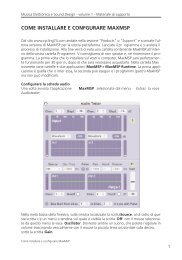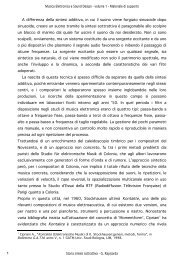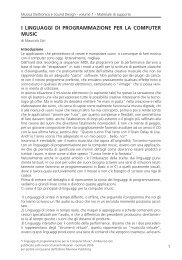programming with max/msp - Virtual Sound
programming with max/msp - Virtual Sound
programming with max/msp - Virtual Sound
You also want an ePaper? Increase the reach of your titles
YUMPU automatically turns print PDFs into web optimized ePapers that Google loves.
3.1<br />
296<br />
Theory<br />
dB<br />
Fig. 3.1 The spectrum of white noise<br />
Paragraph 3.1 - <strong>Sound</strong> sources for subtractive synthesis<br />
Another kind of noise that is used in similar ways for subtractive synthesis is pink<br />
noise. This kind of sound, in contrast to white noise, has a spectrum whose<br />
energy drops as frequency rises. More precisely, the attenuation in pink noise is<br />
3 dB per octave; 2 it is also called 1/f noise, to indicate that the spectral energy<br />
is proportional to the reciprocal of the frequency. (See Figure 3.2.) It is often<br />
used, in conjunction <strong>with</strong> a spectral analyzer, to test the frequency response of a<br />
musical venue, in order to correct the response based on some acoustic design.<br />
dB<br />
�<br />
��<br />
��<br />
��<br />
���<br />
���<br />
���<br />
���<br />
���<br />
���<br />
���<br />
���<br />
���<br />
���<br />
���<br />
���<br />
���<br />
���<br />
���<br />
���<br />
���<br />
��<br />
Fig. 3.2 The spectrum of pink noise<br />
��� ���� ����� �����<br />
frequency<br />
�<br />
��<br />
��<br />
��<br />
���<br />
���<br />
���<br />
���<br />
���<br />
���<br />
���<br />
���<br />
���<br />
���<br />
���<br />
���<br />
���<br />
���<br />
���<br />
���<br />
���<br />
�� ��� ���� ����� �����<br />
frequency<br />
2 Another way to define the difference between white noise and pink noise is this: while the<br />
spectrum of white noise has the same energy at all frequencies, the spectrum of pink noise<br />
distributes the same energy across every octave. A rising octave, designated anywhere in the<br />
spectrum, will occupy a raw frequency band that is twice as wide as its predecessor’s; pink noise<br />
distributes equal amounts of energy across both of these frequency bands, resulting in the constant<br />
3 dB attenuation that is its basic property.<br />
from “Electronic Music and <strong>Sound</strong> Design” Vol. 1 by Alessandro Cipriani and Maurizio Giri<br />
© ConTempoNet 2010 - All rights reserved







